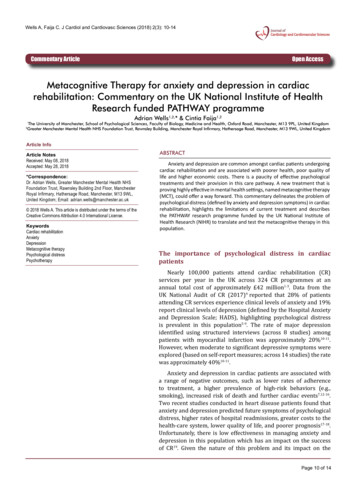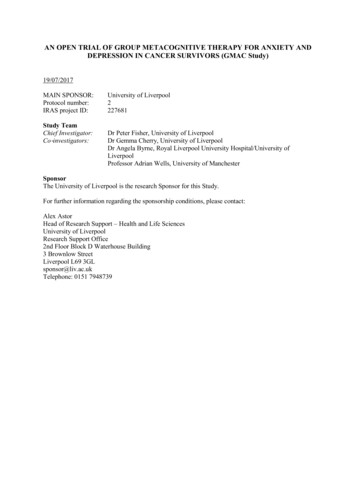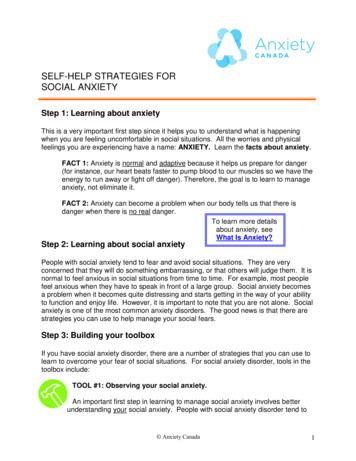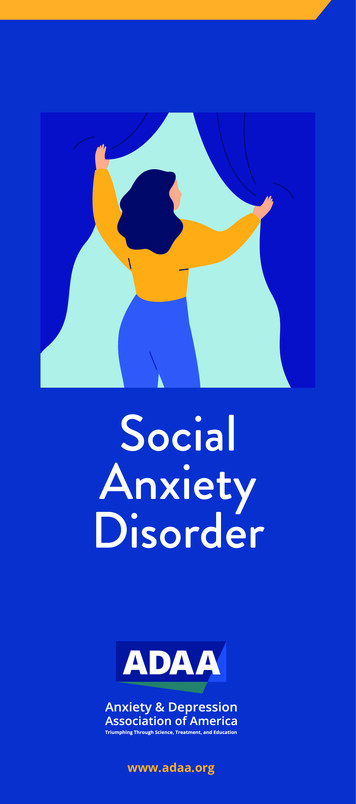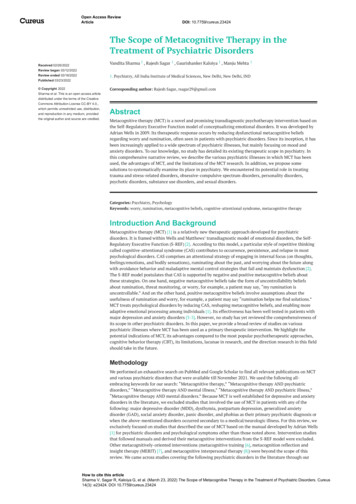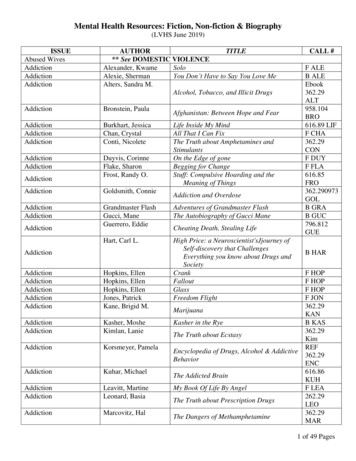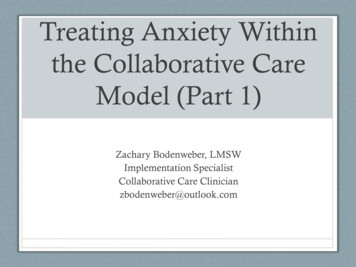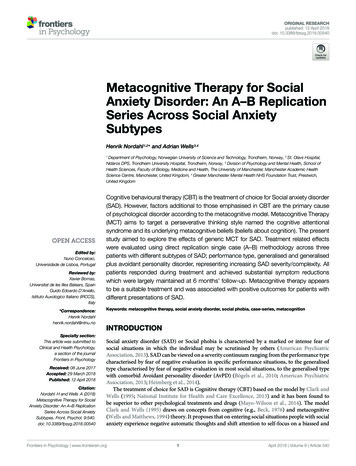
Transcription
ORIGINAL RESEARCHpublished: 12 April 2018doi: 10.3389/fpsyg.2018.00540Metacognitive Therapy for SocialAnxiety Disorder: An A–B ReplicationSeries Across Social AnxietySubtypesHenrik Nordahl 1,2* and Adrian Wells 3,41Department of Psychology, Norwegian University of Science and Technology, Trondheim, Norway, 2 St. Olavs Hospital,Nidaros DPS, Trondheim University Hospital, Trondheim, Norway, 3 Division of Psychology and Mental Health, School ofHealth Sciences, Faculty of Biology, Medicine and Health, The University of Manchester, Manchester Academic HealthScience Centre, Manchester, United Kingdom, 4 Greater Manchester Mental Health NHS Foundation Trust, Prestwich,United KingdomEdited by:Nuno Conceicao,Universidade de Lisboa, PortugalReviewed by:Xavier Bornas,Universitat de les Illes Balears, SpainGuido Edoardo D’Aniello,Istituto Auxologico Italiano (IRCCS),Italy*Correspondence:Henrik Nordahlhenrik.nordahl@ntnu.noCognitive behavioural therapy (CBT) is the treatment of choice for Social anxiety disorder(SAD). However, factors additional to those emphasised in CBT are the primary causeof psychological disorder according to the metacognitive model. Metacognitive Therapy(MCT) aims to target a perseverative thinking style named the cognitive attentionalsyndrome and its underlying metacognitive beliefs (beliefs about cognition). The presentstudy aimed to explore the effects of generic MCT for SAD. Treatment related effectswere evaluated using direct replication single case (A–B) methodology across threepatients with different subtypes of SAD; performance type, generalised and generalisedplus avoidant personality disorder, representing increasing SAD severity/complexity. Allpatients responded during treatment and achieved substantial symptom reductionswhich were largely maintained at 6 months’ follow-up. Metacognitive therapy appearsto be a suitable treatment and was associated with positive outcomes for patients withdifferent presentations of SAD.Keywords: metacognitive therapy, social anxiety disorder, social phobia, case-series, metacognitionINTRODUCTIONSpecialty section:This article was submitted toClinical and Health Psychology,a section of the journalFrontiers in PsychologyReceived: 08 June 2017Accepted: 29 March 2018Published: 12 April 2018Citation:Nordahl H and Wells A (2018)Metacognitive Therapy for SocialAnxiety Disorder: An A–B ReplicationSeries Across Social AnxietySubtypes. Front. Psychol. 9:540.doi: 10.3389/fpsyg.2018.00540Social anxiety disorder (SAD) or Social phobia is characterised by a marked or intense fear ofsocial situations in which the individual may be scrutinised by others (American PsychiatricAssociation, 2013). SAD can be viewed on a severity continuum ranging from the performance typecharacterised by fear of negative evaluation in specific performance situations, to the generalisedtype characterised by fear of negative evaluation in most social situations, to the generalised typewith comorbid Avoidant personality disorder (AvPD) (Bögels et al., 2010; American PsychiatricAssociation, 2013; Heimberg et al., 2014).The treatment of choice for SAD is Cognitive therapy (CBT) based on the model by Clark andWells (1995; National Institute for Health and Care Excellence, 2013) and it has been found tobe superior to other psychological treatments and drugs (Mayo-Wilson et al., 2014). The modelClark and Wells (1995) draws on concepts from cognitive (e.g., Beck, 1976) and metacognitive(Wells and Matthews, 1994) theory. It proposes that on entering social situations people with socialanxiety experience negative automatic thoughts and shift attention to self-focus on a biassed andFrontiers in Psychology www.frontiersin.org1April 2018 Volume 9 Article 540
Nordahl and WellsMetacognitive Therapy for Social Anxiety Disordermetacognitive beliefs. MCT has been found to be an effectivetreatment for depression and several anxiety disorders (Normannet al., 2014), but has yet to be evaluated in its purerform in SAD.We therefore aimed to conduct a preliminary investigationof the efficacy of MCT for SAD using single case methodology.Following the generic MCT conceptualization and treatmentstructure (Wells, 2009), we aimed to test if MCT could be appliedusing a single-case replication methodology that spanned cases ofincreasing complexity. Such an approach constitutes a systematicreplication (Barlow and Hersen, 1984) and the search for cases inwhich the treatment may not work.distorted inner image of the self. Safety behaviours are usedto deal with negative beliefs about how one appears to othersbut impair performance and increase self-focused attention. Inaddition, anticipatory worry and post-event rumination beforeand after social encounters contributes to problem maintenance.This pattern of processing can be traced back to underlyingnegative beliefs and assumptions about the social self (e.g., “I’mboring”).A conceptual feature with the model Clark and Wells (1995)is that whilst it draws on different theoretical frameworks, itplaces cognition rather than metacognition in centre stage. Forexample, it argues that schemas or negative beliefs (e.g., “I’m afailure”) give rise to self-processing and social anxiety. However,the metacognitive model argues that metacognitive beliefs, beliefsabout cognition (e.g., “I cannot control my thinking”), contributemost to disorders including social anxiety (Wells and Matthews,1994). Furthermore, in the cognitive model the emphasis ison challenging the validity of negative social cognitions whilstin MCT the focus is on controlling cognition and modifyingmetacognitive beliefs.In accordance with Wells’ (2000) metacognitive therapyapproach, two studies (Wells and Papageorgiou, 2001; Nordahlet al., 2016b) have shown that a briefer and more metacognitivefocused intervention can be highly effective and time efficient.However, these studies left out several important componentswhich are emphasised in the metacognitive model (Wells andMatthews, 1994, 1996) and retained some of the cognitivecomponents of the Clark and Wells (1995) treatment. Forexample, case-formulations were based on the CBT model,there was some work on testing negative thoughts (eventhough social beliefs were not challenged). However, morerecent research on the relative contribution of social phobicbeliefs (cognitive beliefs) and metacognitive beliefs in a socialanxiety context has shown that metacognitive beliefs but notsocial phobic beliefs predict symptom improvement followingtreatment of social anxiety disorder (Nordahl et al., 2017),work status in high socially anxious individuals (Nordahl andWells, 2017a), and depression symptoms in patients with socialanxiety disorder (Nordahl et al., 2018). Therefore, testing ofwhether a purer metacognitive treatment can be applied andwhether positive effects are associated with it is a greaterpriority.According to the metacognitive model (Wells and Matthews,1994), all psychological disorders are intensified and maintainedby a thinking style called the cognitive attentional syndrome(CAS; Wells, 2009) consisting of worry/rumination, threatmonitoring and maladaptive coping behaviours. Maladaptivemetacognitive beliefs, i.e., beliefs about cognition, give riseto the CAS which in social anxiety take the form ofnegative metacognitive beliefs (“Worry is uncontrollable”),positive metacognitive beliefs (“focusing on an inner imageof myself helps me avoid making a bad impression”) andjudgements of cognitive confidence (“When I am underpressure, I lose my grip on thinking”) (e.g., Nordahl et al.,2016a, 2017; Gkika et al., 2017; Nordahl and Wells, 2017b).Metacognitive therapy (MCT; Wells, 2009) was developedto reduce the CAS and to modify underlying maladaptiveFrontiers in Psychology www.frontiersin.orgMATERIALS AND METHODSDesignIn order to examine the effects associated with MCT for SAD,a single case series using an A–B design with follow up wasimplemented. This study was carried out in accordance with therecommendations of the Regional committees for medical andhealth research ethics in Norway with written informed consentfrom all subjects. All subjects gave written informed consentin accordance with the Declaration of Helsinki. The protocolwas approved by the Regional committees for medical andhealth research ethics (reference number: 2015;1794). Replicationacross three patients with different SAD presentations beginsto establish the generalizability of treatment effects across thedisorder. This is particularly important in SAD as the disorder isfound on a severity continuum. All patients were assigned to notreatment baselines of a minimum of 3 weeks (with the optionof extension if required) to establish stability in the primaryoutcome measure; the fear of negative evaluation (FNE: Watsonand Friend, 1969). No therapeutic input occurred during thebaseline period, but there was contact over telephone to ensurethat the patients completed the self-report measures. Followingthe baseline period, eight sessions of MCT were deliveredweekly with each treatment session lasting between 45 minand 1 h. Patents were followed up 6 months after treatment,and no additional treatment was delivered during the follow-upperiod.ParticipantsThe first three patients with different presentations of socialanxiety consecutively referred to the university outpatientclinical, Department of psychology, Norwegian University ofScience and Technology, were included in the case series. Patientswere assessed using the Structured Clinical Interview for DSMIV Axis I Disorders (SCID-I/P; First et al., 1997b) and Axis IIpersonality disorders (First et al., 1997a). The inclusion criteriawere; (1) a primary diagnosis of SAD, (2) 18 years old orabove, and (3) signed written informed consent in accordancewith the Declaration of Helsinki. The exclusion criteria were;(1) concurrent psychological or drug treatment, (2) evidence ofpsychotic or organic illness, (3) the presence of cluster A or Bpersonality disorder, (4) actively suicidal, or (5) substance oralcohol dependence.2April 2018 Volume 9 Article 540
Nordahl and WellsMetacognitive Therapy for Social Anxiety DisorderPatient 1The Social Interaction Anxiety Scale (SIAS; Mattick andClarke, 1998) is at 20-item scale that measure fear of andresponses to social interactions. It has shown high internalconsistency (α 0.93) and test–retest reliability (0.92). SIAS hasa range from 0 to 80, high scores indicating higher levels of socialanxiety.Beck Anxiety Inventory (BAI: Beck et al., 1988a) is a 21-itemself-report scale designed to assess the severity of somatic andcognitive anxiety symptoms over the previous week. Scores rangefrom 0 to 63, high scores indicating higher levels of social anxiety.BAI has high internal consistency (α 0.92) and good test–retestreliability (0.75) (Beck et al., 1988a).Beck Depression Inventory (BDI: Beck et al., 1961) is a 21item self-report scale assessing current level of depression. BDIhas a range from 0 to 63, high scores indicating higher levelsof depression. The BDI has high internal consistency (α 0.86)and the test–retest reliability has been reported as more than 0.60(Beck et al., 1988b).The MCQ-30 (Wells and Cartwright-Hatton, 2004) is a30-item self-report scale measuring beliefs about thinking.Responses are required on a four-point scale, and the scalestotal score range from 30 to 120. The measures consist offive subscales measuring positive beliefs about worry; negativebeliefs about the uncontrollability of thoughts and correspondingdanger; cognitive confidence; need to control thoughts; andcognitive self-consciousness. High scores reflect more reportedproblems with the item in question. Previous studies have foundthe psychometric properties to be good (Wells and CartwrightHatton, 2004).CAS-1 (Wells, 2009) has four rating scales assessing generalcomponents of the cognitive attentional syndrome (CAS)and general positive and negative metacognitive beliefs. Theinstrument is typically used as a session to session instrumentin MCT when no disorder-specific measure is appropriate.The first scale assesses time spent worrying and ruminatingduring the last week on a scale from 0 (no time) to 8(all the time). The second scale measures threat monitoringin the same fashion. The third scale measures six examplesof unhelpful coping behaviours, such as “avoid situations,”while the fourth scale assesses four examples of negativemetacognitive beliefs (“I cannot control my thinking”) and fourexamples of positive metacognitive beliefs (“Worrying helps mecope”).The Social Phobia Rating Scale (SPRS; Wells, 1997) has fiverating scales assessing key components of one of the mostcommonly employed CT treatments for social phobia (Clarkand Wells, 1995); distress, avoidance, self-consciousness, use ofsafety behaviours, and negative beliefs. In the present study,we used two of the subscales from the SPRS: (1) Use of safetybehaviours; patients are asked to rate how often they use differenttypes of safety behaviours (e.g., “try to relax”) when they havesocial anxiety on a scale ranging from 0 (not at all) to 8 (allthe time). The subscale includes 15 items and therefore thetotal score range between 0 and 120. (2) Negative beliefs; thescale consists of 14 items (e.g., “I look bad”; “They will noticeI’m anxious”), each item ranging from 0 to 100. This scalewas used as measure of social phobic beliefs typical for socialPatient 1 was a 24-year old single woman struggling with theperformance type of SAD for the past 4 years. In particular,making presentations as part of her studies was the majorproblem. She believed that she looked like “a patient withan epileptic seizure” while holding presentations because ofconspicuous shaking. Furthermore, the patient described that shewas anxious and worried a couple of weeks before, and for daysafter, presentations, leading to poor quality of life. Patient 1 hadno comorbid diagnosis, and had never before had psychologicaltreatment.Patient 2Patient 2 was a 70-year old retired man who presented withgeneralised SAD. He had been struggling with social anxietysince adolescence, and described conspicuous “shaking” as hisprimary symptom in social situations. He had psychologicaltreatment for social anxiety 25 years before referral to the clinic,and experienced a brief non-lasting symptom improvementfrom that. The patient had for many years endured most socialsituations with support from his wife. However, some monthsago he started to have panic attacks before social situations andtherefore started to avoid most of them. The patient felt thathis social anxiety now stopped him from having a normal lifetogether with his wife, and that he wasn’t able to break out of thisvicious cycle.Patient 3Patient 3 was a 27-year old single woman who presented withgeneralised SAD, Avoidant personality disorder, and a recurrentdepressive disorder, currently moderately depressed. She hadbeen suffering with social anxiety since she started primaryschool, and had dropped out from her studies several timesbecause of social anxiety. In addition to being afraid of socialembarrassment, the patient presented with low self-esteem anda profound tendency to avoid. The patient reported severaldepressive episodes, the current lasting for 6 months. She hadpreviously had unspecific psychological treatment which hadended 2 years before referral to the clinic. She reported that shehad not found her previous treatment helpful.MeasuresThe Fear of Negative Evaluation scale (FNE; Watson and Friend,1969) is a 30-item measure of apprehension and anxiety overanticipated social evaluations. This measure uses a true-false scaleand has shown good internal consistency (α 0.94) and test–retest reliability (r 0.78) (Watson and Friend, 1969). FNE hasa range from 0 to 30, high scores indicating higher levels of socialanxiety.The Social Avoidance and Distress scale (SAD; Watson andFriend, 1969) is a 28-item measure of distress in social situationsand avoidance, using a true–false scale. Its internal consistencyhas been found excellent (α 0.94) and its test–retest reliabilityranged from 0.68 to 0.79 (Watson and Friend, 1969). SAD has arange from 0 to 28, high scores indicating higher levels of socialanxiety.Frontiers in Psychology www.frontiersin.org3April 2018 Volume 9 Article 540
Nordahl and WellsMetacognitive Therapy for Social Anxiety Disorderphobic patients, ranging from 0 to 1400. The psychometricproperties of the SPRS have been reported as good (Nordahl et al.,unpublished).ProcedureAssessment(4)Patients referred to the outpatient university clinic for treatmentof social anxiety by their GP and other psychiatry services(e.g., the student’s mental health service) were invited toattend an assessment interview for possible participation inthe current study. All patients were assessed by assessorswho were trained in administering the Structured ClinicalInterview for DSM-IV (SCID I and II). Patients completedthe first battery of self-report measures before attending theassessment interview. The baseline period for included patientswas a minimum of 3 weeks showing stable FNE-score (theprimary outcome measure). Therefore, after the assessmentinterview the included patients rated themselves on the FNEand CAS-1 over the succeeding weeks. All patients had astable FNE score over the three first consecutive weeks, andwere therefore scheduled for treatment within a week afterthe third baseline measuring point. During treatment, the FNEand CAS-1 were completed before each session. A completeset of questionnaires was administered post-treatment and at6 months’ follow-up. At post-treatment the SCID I and II wasadministered again by the same assessor who met the patient atpre-treatment.(5)TreatmentThe treatment consisted of eight weekly sessions of 45–60 minduration and followed the generic MCT structure outlined byWells (2009) and consisted of the following elements:(1) A case formulation based on the generic metacognitivemodel was developed. This conceptualization emphasisedthe CAS as the primary maintenance factor of socialanxiety, and showed how different metacognitive beliefdomains give rise to the CAS and how they block adaptivecoping with social anxiety. Following the developmentof the case formulation, patients were socialised to theformulation in order to get a better understanding of howtheir social anxiety persists, and hence what should be thegoals for treatment (abandon CAS strategies, explore andchallenge metacognitive beliefs).(2) The attention training technique (ATT) was introducedto facilitate a metacognitive mode of processing andto allow the patient to make discoveries about flexibleexecutive control. The patients were asked to implementATT twice a day for at least 4 weeks for homework,and in-session practise of the ATT was given in thefirst two sessions. The patients’ experiences with thetechnique were discussed, aiming to facilitate reductionof self-processing strategies and challenging metacognitivebeliefs about the uncontrollability and danger of thoughts.(3) Verbal reattribution strategies were used to modifynegative beliefs concerning the uncontrollability of worryand rumination, and worry/rumination postponementFrontiers in Psychology www.frontiersin.org(6)(7)was introduced to reduce the CAS and as an experiment totest false metacognitive beliefs about these processes beinguncontrollable. Detached mindfulness was introducedwith a link to ATT and presented as an alternative wayto react to negative thoughts such as “What If I soundfoolish” in preference to activation of the CAS.Threat monitoring was addressed, e.g., by an advantagesdisadvantages analysis to address the process ofconstructing the observer perspective in social situations.The consequences of this strategy were highlighted, andpositive metacognitive beliefs about constructing an innerimage (e.g., “constructing an inner image of how I lookhelps me avoid making a bad impression on others”) werechallenged.Two behavioural experiments in combination withSituational Attentional Refocusing (SAR) were conductedintended to counteract threat monitoring in socialsituations, and to facilitate adaptive informationprocessing in a social setting. For example, the patientand therapist went for a 10-min walk. In the first half, thepatients were told to be as self-conscious as possible, inthe second half they were asked to switch their attentionflexibly around and notice the surroundings. Thisexperiment was used to enhance awareness over flexibleattentional control, to highlight the consequences ofself-consciousness and to challenge the patient’s positivebeliefs about self-focused processing. Patients wereasked to try and remember what they had noticed whenself-conscious and when externally focused, the contrastin performance was used to challenge the patient’s beliefthat they had poor cognition. By attributing this to theattentional strategy they were choosing to engage inbeliefs underlying low cognitive confidence could bechallenged.Each patient was encouraged to apply their new awarenessover flexible attentional control when facing challengingsituations, and maladaptive coping strategies such asavoidance were briefly addressed with reference to itsability to prohibit the execution and discovery of adaptivemetacognitive control. Worry and rumination werebanned.Relapse prevention was implemented by making a therapyblueprint in the form of an “old plan –new plan.” Patientswere encouraged to implement the new plan in futuresocial situations to maintain and strengthen the gainsmade over the course of treatment.TrainingAll patients were treated by the first author who is a clinicalpsychologist who has completed the MCT- Institute 2-yeardiploma and treatment was directed and supervised by AdrianWells, the originator of MCT. Treatment used the techniques andstructure as set out in a treatment manual (Wells, 2009).Data AnalysisThe aim of single case research is to determine if there is a cleartreatment effect following the introduction of the intervention,4April 2018 Volume 9 Article 540
Nordahl and WellsMetacognitive Therapy for Social Anxiety Disorderand hence if MCT could be a suitable treatment for SAD.Accordingly, visual examination of graphed data provides astringent test of the treatment effects as only unambiguous effectswill be apparent (Parsonson and Baer, 1992). Therefore, sessionby session scores across baseline, treatment and follow-up onthe FNE and CAS (worry/rumination and threat monitoring)are illustrated. Descriptive statistics are presented for individualpatients at pre-treatment, post-treatment and follow-up on thefollowing measures: FNE, SAD, SIAS, BAI, BDI, MCQ-30, SPRS;social phobic beliefs, and SPRS; use of safety behaviours.RESULTSPre-treatment, post-treatment and follow-up scores for eachpatient on standardised measures of social anxiety (FNE,SAD, SIAS) non-specific anxiety symptoms (BAI), depressivesymptoms (BDI), metacognitive beliefs, use of safety behavioursand rating of social phobic beliefs are presented in Table 1. Eightsessions of MCT were associated with substantial reductions onall measures of social anxiety. At post-treatment, all patientswere asymptomatic on BAI and BDI. Metacognitive beliefs wereaddressed in most treatment sessions, and decreased substantiallyfrom pre to post intervention. Finally, cognitive self-beliefs anduse of safety behaviours showed a substantial decrease frompre to post-treatment, even though these components were notaddressed in treatment. At 6 months’ follow up, treatment gainswere largely maintained.Each patient’s score on the Fear of Negative Evaluation (theprimary outcome measure) and time spent worrying/ruminatingand threat monitoring during the last week during the baseline,treatment and follow-up phase are illustrated in Figure 1. Ascan be seen, all patients showed a stable FNE score acrossthe baseline period. Patient 1 presented with the performancesubtype of SAD, which most likely is the reason why her FNEpre-treatment score was only six points. With the introductionof treatment, rapid and substantial reductions in CAS-activityFIGURE 1 Scores on the Fear of Negative Evaluation (left y-axis), and timespent worrying/ruminating (w/r: CAS-1 item 1) and threat monitoring (t-m:CAS-1 item 2) the last week (right y-axis) across baseline, MCT and follow-upfor each patient.TABLE 1 Descriptive statistics for all the three cases at pre-treatment,post-treatment, and 6 months’ follow-up.MeasurePatient 1Patient 2Patient 2428410MCQ-30523434743739643540Social phobicbeliefs2900068023016096011090Use of safetybehaviours480350302147318can be observed in all three cases. The largest decrease inCAS activity was observed following the first two treatmentsessions for all patients. The graphs also show that the FNEscores changed less rapidly than the CAS, but that theyseem to follow the same trajectory. This result is consistentwith the hypothesised effect of MCT on underlying processrelated variables that are purported to subsequently impacton symptoms. Gains made during treatment were maintainedthrough to the 6 months follow up point, with all patientshaving substantially lower FNE score at 6 months compared tobaseline.Post-treatment Diagnostic AssessmentFNE, Fear of Negative Evaluation; SAD, Social Anxiety and Distress scale; SIAS,Social Interaction and Anxiety Scale; BAI, Beck Anxiety Inventory; BDI, BeckDepression Inventory; MCQ-30, Metacognitions questionnaire 30.Frontiers in Psychology www.frontiersin.orgIn addition to self-report measures, all patients were re-assessedwith the SCID post-treatment by the same assessor they met5April 2018 Volume 9 Article 540
Nordahl and WellsMetacognitive Therapy for Social Anxiety Disordersocial phobic beliefs was not a significant a predictor of symptomimprovement following treatment for SAD, while change inself-consciousness and change in negative metacognitive beliefswere. Likewise, safety behaviours may be a consequence ofthe CAS (e.g., worrying), and not the direct cause of socialanxiety.The results from this study are encouraging; however, thisstudy is only based on three cases with different presentationsof SAD which limits inferences about the generalizability oftreatment effects. Whilst the multiple baseline design controlsfor effects such as time, we are unable to partial-out theeffects specifically due to metacognitive treatment techniques asopposed to non-specific factors. Moreover, although outcomewas measured each week, more frequent measurements andthe use of experience sampling methods could reveal greaterdynamics in the data. The use of only one therapist meansthat it is not possible to determine the influence of factorssuch as skill level. Another limitation is that the assessorswere not blind to the presence/absence of treatment whichmay have influenced the assessor ratings. Moreover, thetreatment delivered in the current study was based ongeneric MCT-principles informed by recent research withinthe field of MCT and SAD, rather than a disorder specificMCT-manual which potentially could make treatment moreefficacious.before inclusion in the study. None of the patients met thediagnostic criteria for SAD following treatment. Patient 3, whoprior to treatment also was diagnosed with comorbid majordepressive disorder and AvPD, did not meet criteria for anydiagnosis post-treatment.DISCUSSIONThe primary aim of the current study was to show any effectsassociated with generic MCT across the social anxiety continuum.Substantial reductions were obtained on all measures of socialanxiety symptoms at post-treatment and at 6 months’ followup. Moreover, MCT seemed to be associated with change inunderlying cognitive style (e.g., worry and self-focus attention)and metacognitive beliefs that according to the metacognitivemodel are implicated in the cause and maintenance of SAD(Wells and Matthews, 1994; Nordahl and Wells, 2017b).Overall the treatment was well tolerated and none ofthe patients reported a worsening of symptoms or distressduring the course of treatment. After eight treatment sessions,none of the patients fulfilled the criteria for a mentaldisorder, and treatment was associated with reductions insocial anxiety, general anxiety symptoms, depressive symptoms,and metacognitive beliefs. Patient 1 who presented with theperformance type of SAD, was asymptomatic after session 5,and could have terminated treatment at that point. Even thoughpatient 1 presented with low scores on self-report symptommeasures, she scored relatively high on self-report measuresof maladaptive metacognitive beliefs. Low symptom scores canpresent a challenge to treat as they can be difficult to formulateoutside of specific exposure to feared situations. However,the elevated metacognition scores may well be a marker foran underlying problem which remains latent until activated.Patient 3 showed a remarkable change during the treatmentperiod, and no longer met the diagnostic criteria for majordepressive disorder or AvPD post-treatment. While recoveryfrom a personality disorder in only eight sessions is striking,similar tendencies have been reported by Hjemdal et al. (2017) inpatients with major depressive disorder and comorbid disordersundergoing MCT for depression.Interestingly, the present study showed that MCT wasassociated with substantial improvements for three patients withdifferent presentations of SAD without addressing elements suchas schemas, negative automatic thoughts or safety behaviourswhich are important factors in CBT. According to CBT models(Clark and Wells, 1995; Rapee and Heimberg, 1997), schemasand safety behaviours are central maintenance factors of selffocused attention and social anxiety symptoms. In the presentstudy we found that cognitive belief ratings and use of safetybehaviours decreased substantially, ev
Keywords: metacognitive therapy, social anxiety disorder, social phobia, case-series, metacognition INTRODUCTION Social anxiety disorder (SAD) or Social phobia is characterised by a marked or intense fear of social situations in which the individual may be scrutinised by others (American Psychiatric Association,2013).

